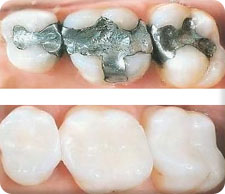 During one dental appointment or another, you may learn that you need a filling. If this is the case, questions about different types of fillings may run through your mind. For many people, the questions are focused on white fillings versus silver amalgams. Which one is better? Is either one harmful? Does either one have any long-term effects?
During one dental appointment or another, you may learn that you need a filling. If this is the case, questions about different types of fillings may run through your mind. For many people, the questions are focused on white fillings versus silver amalgams. Which one is better? Is either one harmful? Does either one have any long-term effects?
Amalgam, sometimes referred to as silver amalgam, contains “mercury combined with other metals including silver, copper and tin.” The silver part of the name refers to the fact that this type of filling has a silver color. “It is one of the oldest filling materials and has been used (and improved) for more than 150 years.”
In addition to being strong and durable, silver amalgam is less expensive than some other materials used for fillings. It seals itself and is not prone to leakage; this means that nothing can seep beneath to cause further decay in the tooth. This type of filling does not usually need to be repaired or replaced. However, it has disadvantages, as well. As the material corrodes, it can become darker in color; although the filling still functions as intended, you may become self-conscious about the color change.
Given the fact that it requires mercury, it must be handled according to specific regulations. “While agencies like the U.S. Food and Drug Administration (FDA), the U.S. Centers for Disease Control (CDC) and the World Health Organization (WHO) have not found evidence of harm from dental amalgam, there are some who have raised concerns about the very low levels of mercury vapor released by amalgam.”
It is important to note that if discoloration occurs, harmless as it is, it cannot be reversed by bleaching. This method for whitening teeth is effective for dealing with color changes caused by a variety of factors, including tobacco and coffee. “If you have a tooth-color filling when your teeth are bleached, the filling will stay yellow—dental restorations do not change color when tooth whitener is applied.”
White fillings, or composite, are a “mix of acrylic resin and powdered glass-like particles that produce a tooth-color filling.” The fact that the color can be matched to other teeth is a tremendous advantage for many people, as is the fact that this type of material is considered to have “good durability” and averts the need to remove a lot of the tooth to complete the restoration. Furthermore, it has a “Low risk of leakage if bonded only to enamel” and it is not susceptible to corrosion. Finally, if new decay occurs, it is very detectable. Given that the material is not the same as your own dental enamel, you may notice that it does not wear at the same rate as your own enamel.
If you need a filling, the staff at Moore Family Dental will work with you to ensure that you have the best and safest option. Dr. Moore, Dr. Redmin, and the entire staff are committed to working with you for your very best oral health. Contact us with any questions.



